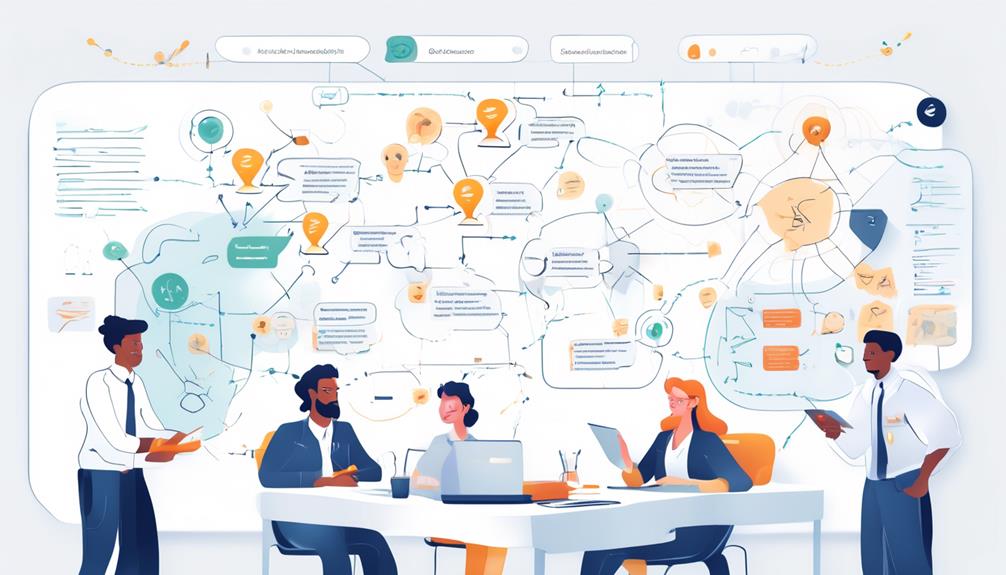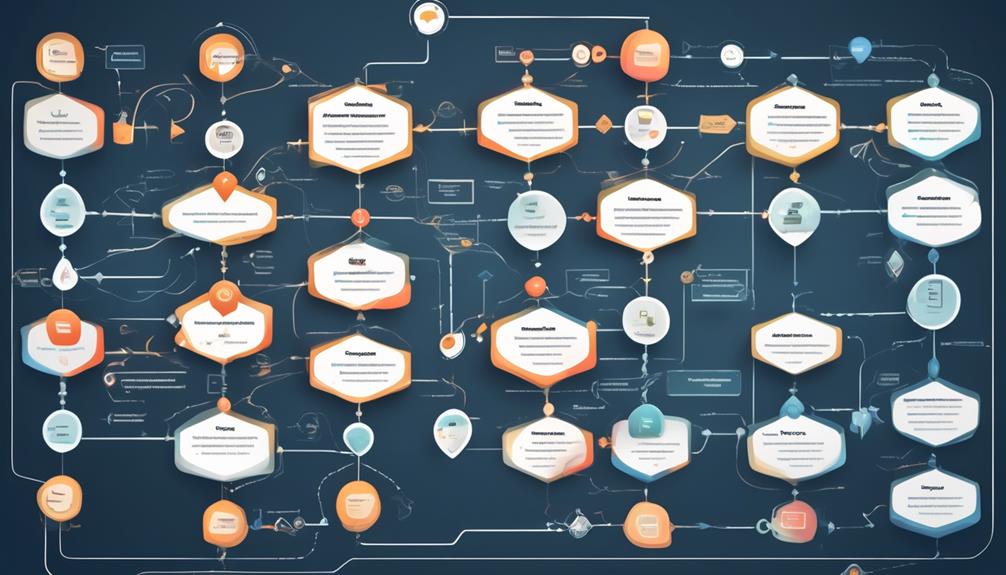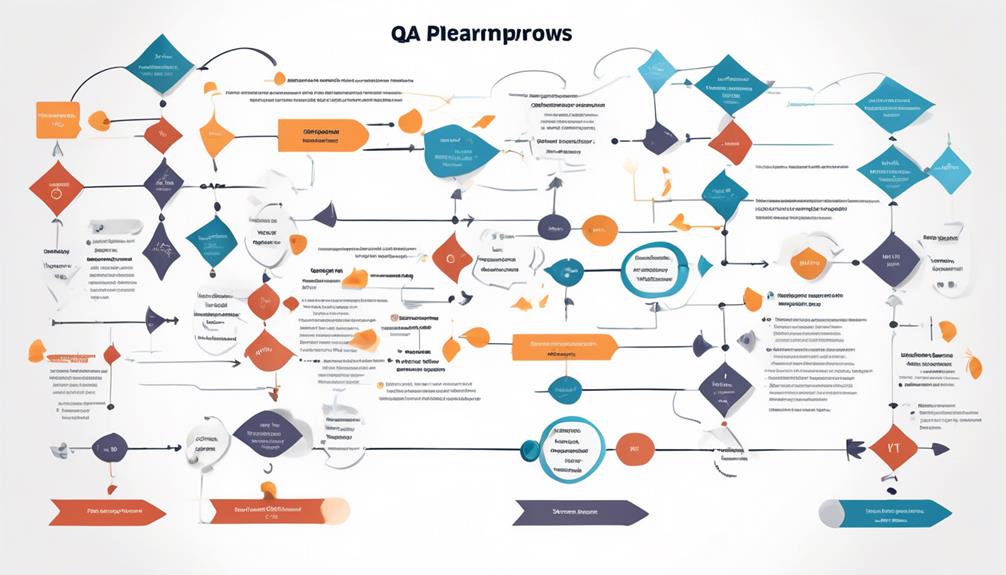We are constantly seeking the best strategies to enhance our testing methods and improve the efficiency of our quality assurance procedures.
There’s a constant drive to optimize our workflows and improve productivity.
But what really makes a difference? How can we ensure that our QA process is running at its peak efficiency?
Let’s explore the key factors that contribute to a more efficient QA process and how they can be implemented to drive better outcomes for our teams and products.
Key Takeaways
- Refine testing methodologies and establish clear objectives to optimize the QA process
- Clarify and document requirements, verifying and validating with stakeholders for effective QA
- Adhere to coding standards, incorporate developer testing, and use checklists for quality code production
- Ensure the right testing environments are set up, pay attention to details, and regularly review test coverage for efficient QA process.
Understanding QA Process Optimization
To effectively optimize the QA process, we must proactively examine and refine our testing methodologies to ensure maximum efficiency and effectiveness throughout the software development lifecycle.
Establishing clear objectives is fundamental to aligning with organizational trajectory and communicating the importance of the QA process.
By implementing communication and reporting practices, we can ensure effective collaboration between stakeholders and establish clear bug reporting channels, thereby enhancing the overall quality of the software.
Emphasizing shift-left testing is crucial as it involves QA teams from project inception, allowing for early identification and resolution of potential issues.
Additionally, automating repetitive tasks not only optimizes costs but also accelerates the QA cycle, leading to a more efficient process.
Test planning strategies play a pivotal role in process improvement, and creating test planning guidelines and defining success metrics for various testing types are essential steps in this regard.
Continuous monitoring, auditing, and improvement of the QA process are imperative, and leveraging tools like TestRail, Selenium, Gatling, Jira, and Sonarqube is instrumental in enhancing software quality.
Clarifying Requirements for QA

Ensuring clear and comprehensive documentation of both functional and non-functional requirements is crucial for establishing a strong foundation in the QA process. Clarifying requirements not only enhances efficiency but also serves as a cornerstone for QA improvement. By clearly defining and documenting requirements, the testing processes become more focused and effective. Establishing a process for verifying and validating requirements with stakeholders is essential to ensure mutual understanding. Visual aids such as flowcharts, wireframes, and mockups further enhance requirement clarity and minimize misinterpretation. Encouraging open communication channels between the QA team, developers, and project stakeholders helps address any requirement ambiguities or inconsistencies. Regularly reviewing and updating the documented requirements is imperative to accommodate changes in the project scope or stakeholder needs.
| Key Actions for Clarifying Requirements | Benefits |
|---|---|
| Define and document requirements | Enhanced efficiency |
| Verify and validate with stakeholders | Mutual understanding |
| Use visual aids for clarity | Minimize misinterpretation |
These key actions lead to a more robust QA process, ultimately improving the overall quality of the product or service.
Ensuring Quality Code Production
We prioritize quality code production by strictly adhering to coding standards and best practices. This ensures that our code is consistent, maintainable, and easily understandable.
Incorporating developer testing as an integral part of our QA process allows us to identify and resolve issues early on. Developer testing catches bugs and issues at an early stage, reducing the need for extensive debugging later in the QA process.
We also use checklists to remind developers of necessary steps and ensure comprehensive testing coverage.
Setting up the right environments for accurate and efficient testing is crucial to avoid inconsistencies that could lead to undetected bugs.
Clear and well-defined requirements are essential to avoid significant issues and ensure that the software aligns with customer expectations.
This approach not only improves our QA process but also contributes to the overall efficiency and quality assurance of our software testing efforts.
Setting Up QA Environments

Transitioning from prioritizing quality code production, we now focus on the crucial aspect of setting up QA environments to ensure accurate testing and efficient quality assurance.
Setting up QA environments involves ensuring that the right testing environments are in place to meet the specific needs of the QA team, technology stack, and tools used. It’s essential to consider the requirements of the QA process and implement developer testing as part of the process.
Checklists can be used to remind developers of necessary steps and to clarify requirements, thus avoiding significant issues during the testing phase.
By setting up QA environments effectively, the QA team can streamline the testing and improving QA process, leading to higher efficiency and better outcomes. This proactive approach to setting up QA environments not only ensures accurate testing but also contributes to the overall quality of the software being developed.
Therefore, it’s crucial to pay close attention to the details and intricacies involved in setting up QA environments to elevate the efficiency of the QA process.
Reviewing Test Coverage Regularly
Regularly reviewing and updating test cases is essential to ensure comprehensive test coverage and to overcome the pesticide paradox. By identifying gaps and adding new test cases, we can improve test coverage and the efficiency of our QA process. It’s crucial to define a schedule for test case review sessions to ensure consistent monitoring and alignment with evolving product features and requirements.
Utilizing test coverage reports can help us identify areas that need additional testing attention, further enhancing the effectiveness of our QA process.
Reviewing test coverage regularly allows us to stay proactive in our approach, ensuring that our testing efforts are always aligned with the most current state of the product. This proactive stance enables us to catch potential issues early, reducing the likelihood of critical bugs slipping through to production.
Additionally, a comprehensive test coverage review process fosters a culture of continuous improvement, driving efficiency gains in our QA process over time. With this approach, we can confidently deliver high-quality products while maximizing our testing resources.
Defining QA for Your Team

We need to ensure that our team has a clear understanding of QA and its importance in the development process.
By defining clear expectations for QA, we can ensure that everyone is aligned and working towards the same goals.
This will help us to streamline our processes and improve overall efficiency.
Team Understanding QA
To ensure a successful understanding of QA within the team, it is crucial for developers and product managers to recognize the pivotal role it plays in software development. Quality assurance (QA) is not just a separate process; it is an integral part of the entire software development lifecycle. By involving a cross-section of the team in QA throughout the build process, everyone gains a deeper understanding of its importance. Clear guidelines and expectations for the development team regarding QA should be established to ensure a unified approach. Highlighting the benefits of QA, such as reducing costs and improving software quality, can further emphasize its significance. The development lead or product owner should take responsibility for ensuring that QA takes place, fostering a culture where the entire team understands and values the QA process.
| Key Points | Description | Importance |
|---|---|---|
| Integral Part of SDLC | QA is not a separate process but an essential part of development | Ensures software quality and customer satisfaction |
| Clear Guidelines | Establishing clear expectations for the development team | Ensures a unified and structured approach |
| Highlighting Benefits | Emphasizing the advantages of QA | Encourages team buy-in and commitment |
Clear QA Expectations
An effective approach to defining QA for your team involves clearly communicating the importance of quality assurance to both developers and product managers. By setting clear QA expectations, you can ensure that the entire team understands the significance of QA in the development process.
Here’s how to achieve this:
- Ensure that the development lead or product owner takes responsibility for ensuring QA processes are in place.
- Establish clear guidelines and expectations for the development team regarding QA.
- Highlight the benefits of QA, including cost reduction and improved software quality.
- Involve a cross-section of your team in QA throughout the build process.
Analyzing Software Requirements

Analyzing the software requirements is a critical step in understanding the needs and expectations of the end users, ensuring that the developed software aligns with their objectives and delivers value. It involves studying and interpreting the functional and non-functional requirements of the software or application.
By identifying and documenting software requirements, a clear roadmap for development and testing activities is created. This not only aids in the development process but also in QA process improvement.
Analyzing software requirements helps in identifying potential areas for improvement and detecting any inconsistencies or gaps in the requirements. It plays a crucial role in ensuring that the developed software aligns with the business objectives and delivers value to the end users.
Additionally, this process facilitates proactive problem-solving by addressing any issues or discrepancies in the early stages of the software development lifecycle.
Ultimately, thorough analysis of software requirements serves as the foundation for a successful software development and testing process, leading to higher efficiency and quality in the final product.
Analyzing Current QA Process

As we analyze our current QA process, we’ll focus on process analysis, efficiency assessment, and improving our QA methods.
We aim to identify areas where our process can be streamlined and made more efficient, ultimately leading to improved product quality.
Process Analysis
To gain insight into the effectiveness of our current QA process, we’ll conduct a comprehensive analysis of its various components and procedures. This process analysis is essential for identifying areas of improvement and enhancing the overall efficiency of our QA process.
Here are the key steps we’ll take:
- Analyze software requirements to ensure alignment with the QA process objectives.
- Evaluate the existing QA process to pinpoint inefficiencies and opportunities for enhancement.
- Employ effective tools such as TestRail, Selenium, Gatling, Jira, and Sonarqube to streamline the QA process.
- Consider factors affecting QA process improvement costs to make informed decisions and optimize resource allocation.
Efficiency Assessment
After thoroughly examining the components and procedures of our current QA process in the previous subtopic, it’s now imperative to assess its efficiency to identify opportunities for enhancement and optimization.
Efficiency assessment involves evaluating the effectiveness of our QA process, analyzing the workflow, tools, and methodologies in use, and reviewing performance metrics and KPIs.
By identifying bottlenecks, inefficiencies, and areas for improvement, we can develop a comprehensive plan to streamline and optimize the QA process.
This assessment allows us to pinpoint areas where improvements can be made to enhance the overall efficiency of our quality assurance efforts.
It’s crucial to continuously assess and improve your QA process to ensure that it aligns with industry best practices and meets the evolving needs of your organization.
Improving QA Methods
We regularly analyze our existing QA process to pinpoint areas for improvement and ensure optimal efficiency. Our focus on improvement involves the following key steps:
- Establishing Clear Objectives: We set clear objectives and communication practices to ensure an effective QA process that aligns with our overall quality assurance goals.
- Implementing Shift-Left Testing and Test Automation: We prioritize shift-left testing and test automation to enhance efficiency and identify defects at early stages of development.
- Developing Test Planning Strategies: We develop comprehensive test planning strategies to streamline our QA process and maximize the utilization of testing tools for improvement.
- Continuous Learning and Improvement: We emphasize the use of QA metrics and KPIs to continuously learn and improve our QA methods, ensuring ongoing enhancement and optimization.
Preparing QA Process Improvement Plan

In order to achieve a more efficient QA process, we will devise a comprehensive improvement plan that addresses key areas of optimization and streamlining. Our approach to testing will involve defining clear objectives aligned with organizational goals and emphasizing the importance of the QA process to all stakeholders. Effective communication and reporting practices will be established to ensure transparency and streamline bug reporting and issue resolution. We will also implement shift-left testing to involve QA teams from project inception and automate repetitive tasks to optimize costs and improve efficiency.
To grab the attention of our audience, here’s a table outlining the key components of our QA process improvement plan:
| Key Areas of Improvement | Action Steps |
|---|---|
| Clear Objectives Alignment | Communicate goals, importance of QA process |
| Effective Communication | Establish transparent reporting practices |
| Shift-Left Testing | Involve QA teams from project inception, automate repetitive tasks |
We will also focus on developing test planning strategies to create guidelines, define success metrics, and engage in comprehensive testing across different aspects of the project. Continuous measurement, updates, knowledge transfers, and feedback will be implemented to monitor and improve the QA process using tools like TestRail, Selenium, Gatling, Jira, and Sonarqube.
Implementing and Monitoring QA Improvements

Upon analyzing our current QA process and identifying areas for improvement, we’ll now focus on implementing and monitoring the QA improvements to enhance overall efficiency and effectiveness.
The following steps are crucial for successful quality assurance process improvement:
- Establish Clear Objectives: Clearly define the goals and objectives of the QA improvements and communicate them effectively to all stakeholders involved in the QA process. This ensures alignment and understanding across the team, fostering a unified effort towards improvement.
- Implement Shift-Left Testing: Involve QA teams from the beginning of the software development lifecycle to identify and address potential issues early on, reducing the likelihood of major defects later in the process.
- Automate Repetitive Tasks: Optimize efficiency and reduce manual efforts by automating repetitive tasks within the QA process. This allows resources to be reallocated to more strategic and impactful testing activities.
- Monitor and Evaluate: Regularly monitor and evaluate the implemented improvements to ensure their effectiveness. This includes tracking key performance indicators, gathering feedback, and making necessary adjustments to maintain a robust QA process.
Establishing Communication and Reporting

Communication channels and reporting protocols should be established to facilitate effective collaboration and issue resolution between developers and QA testers. By outlining clear documentation and communication channels, the QA process efficiency can be significantly improved.
Standardizing reporting formats ensures that information is conveyed in a clear and consistent manner, reducing the likelihood of misunderstandings. This also enables team members to easily comprehend and act upon the information provided.
Effective communication between developers and QA testers is crucial for efficient issue resolution, and establishing clear channels for reporting bugs and issues streamlines the entire problem-solving process. Additionally, by ensuring that all stakeholders have opportunities to initiate contact and contribute to the communication flow, the overall efficiency of the QA process can be enhanced.
It’s essential for the QA manager to take a proactive approach in enabling and overseeing these communication and reporting processes, as they play a pivotal role in the successful execution of QA activities.
Shifting Left in QA

Shifting Left in QA involves integrating QA teams into the software development process from the outset, allowing for early testing and proactive issue resolution. This approach emphasizes collaboration and decision-making involvement of QA teams to identify and resolve issues promptly. By implementing shift-left testing, costs can be reduced, and a smooth project pipeline can be maintained. Automation of repetitive tasks through tools reduces manual labor and optimizes costs.
Additionally, developing test planning strategies to define success metrics for regression testing, performance testing, security testing, and usability testing is essential.
- Early Integration: Involving QA teams from project inception enables early testing in the software development lifecycle, leading to proactive issue resolution.
- Cost Reduction: Implementing shift-left testing can lower costs and maintain a smooth project pipeline.
- Automation: Test automation reduces manual labor, optimizes costs, and allows for efficient testing processes.
- Comprehensive Test Planning: Developing test planning strategies defines success metrics for various types of testing, ensuring thorough assurance (QA) throughout the software development lifecycle.
Automating Testing Processes

Let’s consider the critical aspects of tool selection and script maintenance when it comes to automating testing processes.
Efficient tool selection is paramount in ensuring that the chosen automated testing tools align with the specific needs and requirements of the QA process.
Additionally, proactive script maintenance is essential for sustaining the long-term effectiveness and reliability of the automated testing framework.
Tool Selection
To improve the efficiency of the QA process, careful consideration must be given to the selection of automation tools for testing processes. When choosing automation tools, several best practices should be considered:
- Project Complexity: Evaluate the complexity of projects and end users to determine the most suitable automation tools.
- Technology Stack: Consider the technology stack to ensure compatibility and seamless integration with existing systems.
- Cost Evaluation: Assess the cost of QA process improvement, including licensing, training, and implementation costs.
- Task Automation: Select tools that can automate repetitive tasks, increase test coverage, and expedite the QA cycle.
Script Maintenance
Automating testing processes through script maintenance is a crucial aspect of improving QA process efficiency, ensuring consistent and reliable test execution while saving time and effort. QA teams must prioritize regular updates and maintenance of test scripts to guarantee accurate and effective automated testing.
This proactive approach not only speeds up the testing process but also aids in early issue identification. By reducing the possibility of human error, automated testing processes contribute to overall testing efficiency. Effective script maintenance is essential for QA teams to leverage the full potential of automation in testing.
It’s imperative for QA teams to understand that script maintenance isn’t a one-time task but an ongoing process that significantly impacts the effectiveness of automated testing.
Developing Test Planning Strategies

Developing test planning strategies involves understanding the importance of defining success metrics for regression, usability, and performance testing and implementing clear guidelines to ensure accurate and efficient testing. To enhance QA process efficiency, our development team should consider the following strategies:
- Set baseline measures for performance and security testing to guide the test planning process. This ensures that the testing process is aligned with the expected performance and security standards, allowing for early identification and resolution of potential issues.
- Engage in security testing across all attack vectors as part of the test planning strategy. By comprehensively assessing security from various angles, potential vulnerabilities can be identified and addressed, contributing to a more robust and secure end product.
- Define a schedule for test case review sessions to enhance test planning effectiveness. Regular review sessions facilitate continuous improvement of test cases, ensuring they remain relevant and comprehensive throughout the development lifecycle.
- Implement a collaborative approach to test planning involving the development team. Involving relevant stakeholders in the test planning process ensures that different perspectives are considered, leading to a more thorough and effective test strategy.
Frequently Asked Questions
How Can We Improve QA Efficiency?
Improving QA efficiency involves optimizing processes, leveraging automation, and fostering collaboration.
We analyze current workflows, identify bottlenecks, and prioritize automation opportunities.
Our team implements test scripts, continuous integration, and deployment pipelines to streamline testing.
We proactively communicate with stakeholders to ensure alignment and gather feedback for continuous improvement.
How Can I Improve My QA Process?
Improving our QA process involves refining test strategy and optimizing test execution. We integrate automation for repetitive tasks, enhancing efficiency.
Clear communication and collaboration foster a unified approach. By incorporating feedback loops, we continuously refine our process.
Defining clear objectives and regular reviews ensure alignment with requirements. Incorporating developer testing and proactive gap identification elevates our QA process efficiency.
This visualizes our journey towards a streamlined, efficient QA process.
What’s an Example of How You Enhanced the QA Process in Your Last Job?
In our last job, we enhanced the QA process by implementing shift-left testing, involving QA teams from project inception. This reduced costs and maintained a smooth project pipeline.
Additionally, we utilized automation tools, reducing manual effort and enabling faster release cycles.
Clear communication and reporting practices were established, ensuring all stakeholders had opportunities to initiate contact.
We also developed test planning strategies, creating guidelines for QA departments and defining success metrics for various testing types.
What Is the Best Way to Make Quality Assurance Into Your Process?
To maximize quality assurance integration, we prioritize proactive planning and persistent participation. By involving QA teams from the project’s inception, we identify potential issues early.
Utilizing automation tools reduces manual effort and increases efficiency. Risk-based testing prioritization minimizes business risks.
Comprehensive documentation, defect tracking, and actionable insights ensure continuous improvement. This proactive and participative approach elevates our QA process efficiency and enhances overall product quality.
Conclusion
In conclusion, by embracing automation tools and implementing efficient testing strategies, we can revolutionize our QA process. We can dramatically reduce manual labor, increase test coverage, and accelerate the overall testing process.
With these powerful tools at our disposal, we’ve the potential to elevate our QA process efficiency to unprecedented levels, ensuring the delivery of high-quality software products and meeting the needs of our customers with precision and excellence.









